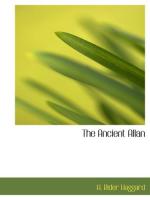I spent a very instructive two hours in the museum, studying various Egyptian antiquities including a couple of mummies which rather terrified me. They looked so very corpse-like standing there in their wrappings. One was that of a lady who was a “Singer of Amen,” I remember. I wondered where she was singing now and what song. Presently I came to a glass case which riveted my attention, for above it was a label bearing the following words: “Two Papyri given to Lady Ragnall by the priests of the Kendah Tribe in Africa.” Within were the papyri unrolled and beneath each of the documents, its translation, so far as they could be translated for they were somewhat broken. No. 1, which was dated, “In the first year of Peroa,” appeared to be the official appointment of the Royal Lady Amada, to be the prophetess to the temple of Isis and Horus the Child, which was also called Amada, and situated on the east bank of the Nile above Thebes. Evidently this was the same temple of which Lady Ragnall had written to me in her letter, where her husband had met his death by accident, a coincidence which made me start when I remembered how and where the document had come into her hands and what kind of office she filled at the time.
The second papyrus, or rather its translation, contained a most comprehensive curse upon any man who ventured to interfere with the personal sanctity of this same Royal Lady of Amada, who, apparently in virtue of her office, was doomed to perpetual celibacy like the vestal virgins. I do not remember all the terms of the curse, but I know that it invoked the vengeance of Isis the Mother, Lady of the Moon, and Horus the Child upon anyone who should dare such a desecration, and in so many words doomed him to death by violence “far from his own country where first he had looked on Ra,” (i.e. the sun) and also to certain spiritual sufferings afterwards.
The document gave me the idea that it was composed in troubled days to protect that particularly sacred person, the Prophetess of Isis whose cult, as I have since learned, was rising in Egypt at the time, from threatened danger, perhaps at the hands of some foreign man. It occurred to me even that this Princess, for evidently she was a descendant of kings, had been appointed to a most sacred office for that very purpose. Men who shrink from little will often fear to incur the direct curse of widely venerated gods in order to obtain their desires, even if they be not their own gods. Such were my conclusions about this curious and ancient writing which I regret I cannot give in full as I neglected to copy it at the time.
I may add that it seemed extremely strange to me that it and the other which dealt with a particular temple in Egypt should have passed into Lady Ragnall’s hands over two thousand years later in a distant part of Africa, and that subsequently her husband should have been killed in her presence whilst excavating the very temple to which they referred, whence too in all probability they were taken. Moreover, oddly enough Lady Ragnall had herself for a while filled the role of Isis in a shrine whereof these two papyri had been part of the sacred appurtenances for unknown ages, and one of her official titles there was Prophetess and Lady of the Moon, whose symbol she wore upon her breast.




